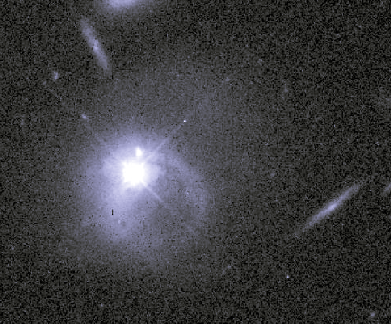Explanation: In 1963 astronomers were astounded to discover that certain faint, star-like objects have very large redshifts. The large redshifts imply that these objects, now known as quasars (QUASi-stellAR objects), lie near the edge of the observable Universe. To be visible at such extreme distances of billions of light years, they must emit tremendous amounts of energy. Where does the energy come from? In the most widely accepted model, a quasar is the bright nucleus of an active galaxy powered by a central, supermassive black hole. This Hubble Space Telescope image shows a quasar known as PKS 2349 (the star-like object near the center) and a galaxy (surrounding fuzzy patch), but the quasar is not at the galaxy's center! In fact, the galaxy and quasar seem to be colliding or merging. This and other recent HST observations suggest that astronomers' standard ideas about quasars may be wrong.
1999 2000 2001 2002 2003 2004 2005 2006 2007 2008 2009 2010 2011 2012 2013 2014 2015 2016 2017 2018 2019 2020 2021 2022 2023 2024 2025 |
Январь Февраль Март Апрель Май Июнь Июль Август Сентябрь Октябрь Ноябрь Декабрь |
NASA Web Site Statements, Warnings, and Disclaimers
NASA Official: Jay Norris. Specific rights apply.
A service of: LHEA at NASA / GSFC
& Michigan Tech. U.
|
Публикации с ключевыми словами:
quasar - квазары - взаимодействующие галактики
Публикации со словами: quasar - квазары - взаимодействующие галактики | |
См. также:
Все публикации на ту же тему >> | |
